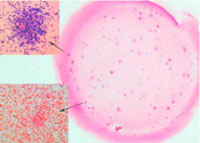A gene editing process that corrects mutations without introducing foreign genetic material into the chromosome was demonstrated in diseased human cells for the first time.

A gene editing process that corrects mutations without introducing foreign genetic material into the chromosome was demonstrated in diseased human cells for the first time. The method may be a more effective and less dangerous alternative to gene therapy methods, which caused leukemia in some of the patients.
A team led by scientists at Sangamo Biosciences in Richmond, California, reported that they were able to correct a single gene mutation that caused a fatal X chromosome, carrying the immunodeficiency disease X-SCID, also known as the "bubble kids." They treated the cells in test tubes using the company's proprietary zinc finger nucleases (ZFNs) technology and published the research results in Nature.
ZFN are proteins made of "fingers" of about thirty amino acids and stabilized by a zinc atom, which cut an enzyme called nuclease.
Using different combinations of amino acids, they can be programmed to attach to the DNA exactly where the mutant gene is and cut it. This encourages the body's natural repair system, homologous recombination, which repairs the gene where the DNA was cut. The researchers were able to provide the cells with a copy of the normal gene as a basis for reference.
Boys who suffer from bubble children's disease, have an abnormal gene on the X chromosome that makes their immune system particularly vulnerable. In 2000, Alan Fisher at the Necker Hospital in Paris, France, treated 10 children with the disease using a retrovirus from a mouse that carried a copy of the normal gene. Although the treatment was successful, at least two of the children developed leukemia, and one of them died as a result. This was due to the fact that the insertion location of the new gene cannot be controlled and this may end up with the insertion of the gene next to another called LMO2. This controls cell growth and can cause cancer if expressed at the wrong time.
On the other hand, ZFN is a technology that allows great precision. "ZFN focuses on placing the normal genes in the normal chromosomal location, where it will not cause unruly genetic circumstances." explains Dana Carroll, a biologist at the University of Utah in Salt Lake City who used ZFN to repair damaged genes in fruit flies.
However, Carol warns that the possibility of side effects cannot yet be ruled out. "There is still a danger of the development of alternative phenomena. For example, some types of cancer, scientists in the field still believe, are caused by chromosomes that have broken and reattached in the wrong way.
perform their medical operation
Mathio Fuertos of the University of Texas Southwestern Medical Center at The Dalles, and author of an article published in Nature in 2003, ZFN may encourage homologous recombination in human cells, but it repairs "model genes" and not necessarily disease-causing genes. Moreover, both Porteus and Carroll were only able to repair the genes in a few percent of the treated cells.
In the latest study, the genes were able to repair about 18% of the treated cells, enough to make the method good enough from a medical point of view. "The Sangamo Group has achieved remarkable efficiency," said Carol. The researchers said that the progress was achieved thanks to the specific matching of a pair of ZFN fingers, each of which binds to six base pairs, precisely on target. "They used more complex ZFN combinations than they had tried before," says Carol. "This is a satisfying demonstration of the power of the underlying ZFN technology."
The main goal of the Sagamanu people is to take blood samples from patients, correct the genetic errors and inject them back into the body. In addition to X-SCID, they say they will try to treat other genetic diseases caused by single gene mutations, including sickle cell anemia and beta thalassemia. They suggest that immune cells may also be modified to prevent HIV infection.
For news in New Scientist
He knew genetic medicine
https://www.hayadan.org.il/BuildaGate4/general2/data_card.php?Cat=~~~127020867~~~25&SiteName=hayadan
